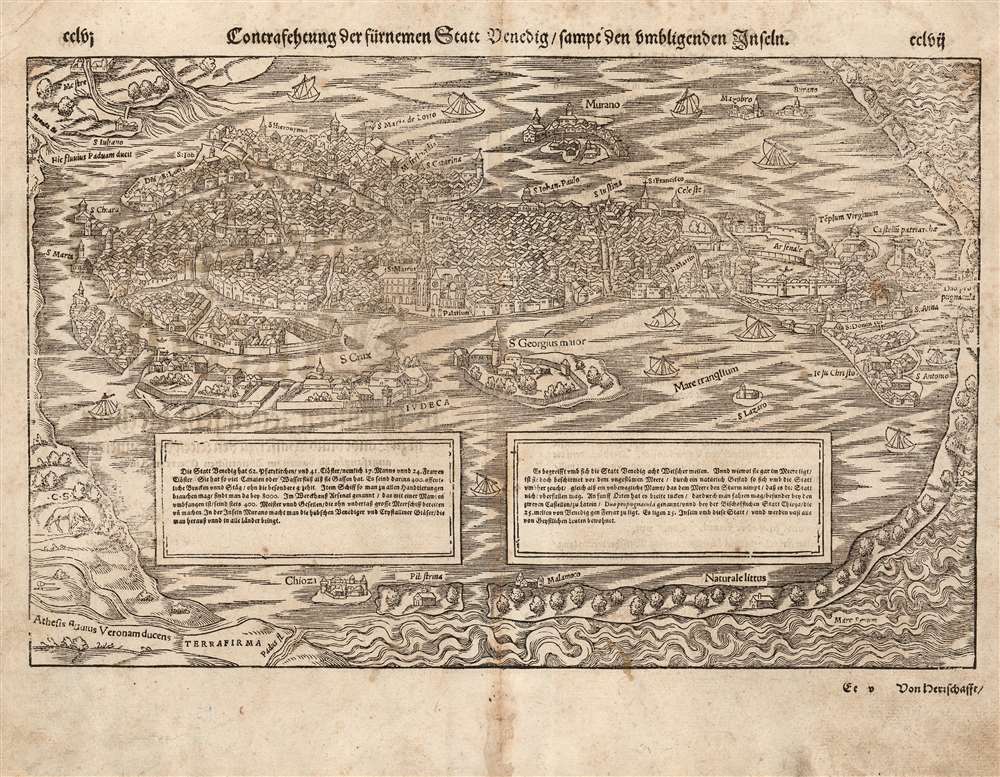This item has been sold, but you can get on the Waitlist to be notified if another example becomes available, or purchase a digital scan.
1588 Munster Woodcut View of Venice
Venice-munster-1588
Title
1588 (undated) 10 x 15.75 in (25.4 x 40.005 cm)
Description
Adding to the Cosmographia
This view does not appear in Munster's work prior to 1550. Munster himself constantly labored to build the work until his death by plague in 1552, both adding to the text as well as ordering the production of improved city views. 1550 saw the addition of many of these. Both this view of Venice, and the view of Rome appearing the same year, were the work of a woodcutter known only to us by his initials, 'C.S.' which sometimes appear in conjunction with a rendering of the tools of his trade (a knife and a chisel), and sometimes in alongside the initials of the woodcutter David Kandel. It is remotely possible that the woodcutter in question is Christoph Schweitzer who produced a very fine 1595 view of Durham, England, but so long an active career during this period beggars the imagination.Publication History and Census
This map was cut by the woodcut artist known as 'the monogrammist C.S.,' probably Christoph Schweicker, for inclusion the 1550 edition of Cosmographia Universalis. Like most of the views and maps from the body text of the work, it was retained in 1588 even after the double-page foretext maps were replaced. This example of the map corresponds to the 1588 German edition of Cosmographey. The individual view appears in nine citations in OCLC, in varying editions.CartographerS
Sebastian Münster (January 20, 1488 - May 26, 1552), was a German cartographer, cosmographer, Hebrew scholar and humanist. He was born at Ingelheim near Mainz, the son of Andreas Munster. He completed his studies at the Eberhard-Karls-Universität Tübingen in 1518, after which he was appointed to the University of Basel in 1527. As Professor of Hebrew, he edited the Hebrew Bible, accompanied by a Latin translation. In 1540 he published a Latin edition of Ptolemy's Geographia, which presented the ancient cartographer's 2nd century geographical data supplemented systematically with maps of the modern world. This was followed by what can be considered his principal work, the Cosmographia. First issued in 1544, this was the earliest German description of the modern world. It would become the go-to book for any literate layperson who wished to know about anywhere that was further than a day's journey from home. In preparation for his work on Cosmographia, Münster reached out to humanists around Europe and especially within the Holy Roman Empire, enlisting colleagues to provide him with up-to-date maps and views of their countries and cities, with the result that the book contains a disproportionate number of maps providing the first modern depictions of the areas they depict. Münster, as a religious man, was not producing a travel guide. Just as his work in ancient languages was intended to provide his students with as direct a connection as possible to scriptural revelation, his object in producing Cosmographia was to provide the reader with a description of all of creation: a further means of gaining revelation. The book, unsurprisingly, proved popular and was reissued in numerous editions and languages including Latin, French, Italian, and Czech. The last German edition was published in 1628, long after Münster's death of the plague in 1552. Cosmographia was one of the most successful and popular books of the 16th century, passing through 24 editions between 1544 and 1628. This success was due in part to its fascinating woodcuts (some by Hans Holbein the Younger, Urs Graf, Hans Rudolph Manuel Deutsch, and David Kandel). Münster's work was highly influential in reviving classical geography in 16th century Europe, and providing the intellectual foundations for the production of later compilations of cartographic work, such as Ortelius' Theatrum Orbis Terrarum Münster's output includes a small format 1536 map of Europe; the 1532 Grynaeus map of the world is also attributed to him. His non-geographical output includes Dictionarium trilingue in Latin, Greek, and Hebrew, and his 1537 Hebrew Gospel of Matthew. Most of Munster's work was published by his stepson, Heinrich Petri (Henricus Petrus), and his son Sebastian Henric Petri. More by this mapmaker...
Christoph Schweicker (fl. 1550) was a German-Swiss woodcut artist living and working in the Rhine region in the mid 16th century. He is probably both the so-called 'monogrammist CS' who produced many of the views for the 1550 edition of Sebastian Münster's Cosmographia; he is also probably 'the Master Christoph' who executed the Nicholaos Sophianos map of Greece in Basel, signing the work 'CHS.' These attributions cannot be conclusive, given the lack of biographical information generally available for the woodcut craftsmen of this period. Learn More...

